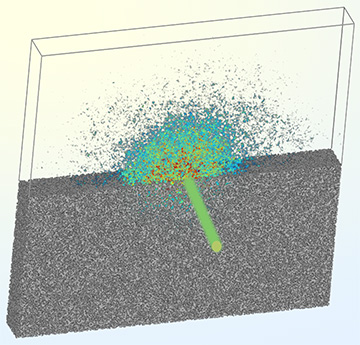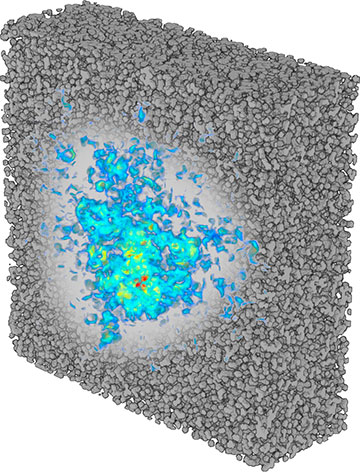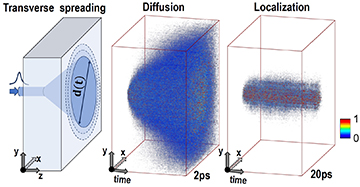
Researchers at academic institutions in the United States and France and at the US-based firm Flexcompute have reported numerical simulations of Anderson localization of light in 3D media—a long-sought goal. [Image: Courtesy of A. Yamilov]
For some four decades, researchers have looked for evidence in electromagnetic waves of so-called Anderson localization—a Nobel Prize–winning description of how a medium’s level of disorder affects diffusive wave propagation within it. But while Anderson localization of light has cropped up in 1D and 2D systems, experiments in 3D systems have stubbornly refused to yield clear evidence of it. And the problem is so complex that fully capturing it also lies outside the realistic boundaries of most numerical techniques—at least for any system large enough to be interesting.
Now, a research team led by Hui Cao of Yale University, USA, reports that it has broken through that conceptual barrier. In the new work, the team presents numerical simulations that capture the conditions for Anderson localization of light in a 3D system of large size, and across wide variations in refractive index (Nat. Phys., doi: 10.1038/s41567-023-02091-7). The key to the advance, according to the researchers, is a software tool developed by a commercial provider, Flexcompute, that reportedly can slash the computation time required for “brute force” light-transport simulations from days to less than half an hour.
The team’s new simulations hold some surprises. A big one is that 3D Anderson localization of light is unlikely to occur at all in dielectric media—the place where most experimentalists have been looking for it for more than a quarter-century. On the other hand, the simulations did show evidence for localization of light in metallic media. Both findings, the researchers believe, could be of interest both for fundamental research and for applications.
“This has been a 40-year mystery, a 40-year pursuit,” Cao told OPN, speaking of the quest for evidence of 3D Anderson localization of light. “What’s important here is that we can finally give a definite answer to this long debate by presenting a very clear numerical result.”
Stopping wave diffusion in its tracks
The physicist Philip Anderson first described what came to be called Anderson localization in a landmark Physical Review paper in 1958. His treatment there specifically addressed the case of a material’s transition from an electrical conductor to an insulator. Anderson’s theoretical work showed that when a certain threshold of disorder is reached in the material, diffusive transport of electrons in the medium will effectively come to a halt. Instead, the electron wavefunctions will become localized in the material, owing to interference effects from the many different paths of electron scattering.
Ordinarily, waves traveling through a medium will tend to spread diffusively (middle panel). In the theory of Anderson localization, if the medium becomes sufficiently disordered, diffusive spreading will be halted, and the wave becomes localized owing to interference effects (right panel). [Image: Courtesy of A. Yamilov] [Enlarge image]
While Anderson’s initial work, for which he received the Nobel Prize in Physics in 1977, dealt with electron wavefunctions, Anderson localization turns out to be a general phenomenon applicable to all wave systems—including light. In the case of light, such localization would in principle be revealed when the system became so disordered that light ceased to spread out diffusively across an entire volume of material (as it does, for example, in air or even fog) and instead became confined to a narrower region, never to escape.
Ever since Anderson
In a later paper in 1985 that dealt specifically with the case of light waves, Anderson suggested that the ideal system for observing such localization might be a “random packing of metallic balls of the right size.” But experimentalists looking for Anderson localization of light in 3D largely abandoned metallic media at an early stage. That’s because metals are so effective at absorbing light that it would be difficult to separate the effect of that absorption from true Anderson localization.
For that reason, experimental quests for evidence of 3D localization of light have instead focused on dielectric systems, where one might expect a clearer signal. Here, though, the results have been disappointing, owing to experimental artifacts and other problems. As a result, unambiguous evidence of localization in 3D has been elusive.
Embracing the “indignity” of simulations
Anderson himself seems to have recognized the problem. In his Nobel Prize speech in 1977, he said that the localization phenomenon that bears his name “has yet to receive adequate mathematical treatment, and one has to resort to the indignity of numerical simulations to settle even the simplest questions about it.”
Even numerical simulations of Anderson localization are no mean feat.
But even numerical simulations of Anderson localization are no mean feat. The gold standard for such simulations—first-principles calculations of solutions to Maxwell’s equations—have generally been prohibitively expensive, with “extraordinarily long computational times” for all but relatively small systems, according to the authors of the new paper. And approximations to speed up the computation can cause problems as well. “You don’t know how correct your result is,” Momchil Minkov, an employee of Flexcompute and a coauthor on the new paper, explained to OPN, “because approximations you took might be creating artifacts.”
The software/hardware setup offered by Flexcompute—a finite-difference time-domain (FDTD) solver called Tidy3D—aims to resolve that dilemma. The system draws on recent advances in computer hardware driven by the massive requirements of AI and machine learning—advances that, Minkov said, can also be applied to simulations that have nothing to do with AI. “What we do is basically pick the best hardware for the purpose of solving Maxwell’s equations,” he told OPN, “and write the software to utilize that hardware.” The system resides on Flexcompute’s servers and can be accessed by commercial and academic clients remotely. “You just need a laptop and an internet connection.”
This hosted platform, the team says, can provide speedups of a hundred to a thousand times for brute-force simulations of light transport. “Some simulations that we expect would take days to do, it can do in just 30 minutes,” Cao said. And the paper’s first author, Alexey Yamilov of the Missouri University of Science and Technology, USA—who described himself as “the one sitting at the laptop”—added, “I can tell you, this really feels like magic.”
“Why not metal?”

The team numerically simulated light transport in a 3D assemblage of nanoscale spheres at varying degrees of disorder, to look for signs of Anderson localization. [Image: Courtesy of A. Yamilov]
Yamilov, Cao and their colleagues used that hardware-optimized computational magic to run full simulations of 3D light transport across a range of scenarios—something that the Flexcompute setup’s blazing speed finally made possible. The team started by looking at how light would propagate through a slab of randomly packed 3D dielectric nanospheres, at different filling fractions, refractive indices ranging from 3.5 to 10 and frequencies in both the visible and the microwave regions. Even after painstaking work to iron out any possible artifacts, the team found no evidence of localization in these simulated dielectric systems. “We were almost at the point of despair,” said Yamilov. “We were not able to find the localization in the system where everyone has been looking for it for the last 25 years.”
Then, according to Cao, another coauthor, Zongfu Yu—an electrical-engineering professor at the University of Wisconsin–Madison, USA, and a cofounder of Flexcompute—suggested that the team take another look at a metallic system. “I still remember him saying, ‘So why don’t you try metal’ … And I was thinking, ‘Yeah—why not metal?’ ” Cao said.
She noted that for those who have worked on Anderson localization, “the whole community’s mindset” has been focused on dielectric systems. “Zongfu never worked on Anderson localization before,” Cao said. “It is a great example of how an outsider can give a very important insight on a situation.”
When the researchers turned to simulating a system of metal spheres instead of dielectric ones, the contrast was striking. The team found what it describes in the paper as the first numerical evidence of Anderson localization of electromagnetic waves in a random metallic-particle ensembles, across a wide spectral range—which the researchers were able to confirm using eight separate criteria.
Toward future experiments and applications
One clear outcome of the numerical research will likely be to shift experimental efforts on Anderson localization away from dielectric systems and toward low-loss metallic ones. “From my perspective, the negative result—finding no localization in dielectrics, even going at very high refractive index—is very important,” Minkov said, “because a lot of people were trying to do that experiment.”
One clear outcome of the numerical research will likely be to shift experimental efforts on Anderson localization away from dielectric systems and toward low-loss metallic ones.
In the lab, finding actual experimental evidence of Anderson localization in metallic systems could still prove difficult. As part of the new study, however, the researchers have proposed what they call “a realistic microwave experiment” that might separate the effects of light localization from light absorption in the system, and thereby avoid the pitfalls of some previous efforts.
Beyond fundamental research, Cao thinks the work could spur new applications—though she acknowledges that some are speculative. For example, she noted that Anderson localization could enable much more efficient trapping of light in random lasers, an area in which she’s worked for many years. And localization conceivably could allow light to be better hemmed in and used in some photo-electrochemical processes involving metals, such as catalysis and energy storage.
Meanwhile, for the Flexcompute system that enabled the work, the team sees substantial prospects, both in fundamental academic research and in commercial areas. Tidy3D, Minkov pointed out, is already being used in the design of integrated photonics for chip-to-chip communications, and could prove useful in emerging areas such as metalenses. “We’re hoping people will do exciting things with it,” he said.


